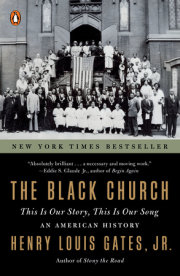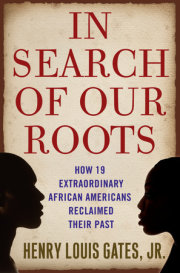1
Which journalist was among the first to bring black history facts to the masses? For black families in the middle of the twentieth century, “Mr. Rogers” was a columnist for the legendary
Pittsburgh Courier, and his pithy and always intriguing tidbits of African and African-American history armed them with facts about the black experience that seemed more like fantasies. Since students weren’t being taught anything about black people at school, Joel A. Rogers was just about the only source of black history that a few generations had.
The first edition of his now legendary
100 Amazing Facts About the Negro with Complete Proof, published in 1957, was billed as “A Negro ‘Believe It or Not,’ ” signifying on Robert Ripley’s brain-bending series that had premiered in the
New York Globe in October 1919. Rogers’s little book was priceless because he was delivering enlightenment and pride, steeped in historical research, to a people too long starved on the lie that they were worth nothing because their ancestors had
contributed nothing to world civilization. Deep in his bones, Rogers knew what a lie that was, and he used every ounce of creative energy he had to expose the twin fallacies on which it was based: racial purity and white supremacy. For African Americans of the Jim Crow era, Rogers was their first black history teacher. And he wrote to educate, with the black everyman and everywoman foremost in his mind.
Did he sometimes embellish what he had found? Yes; he wasn’t above shock journalism. Did he miss key details? Absolutely. His style was brief and to the point, using a minimum of words and ambiguity so that the “facts” could speak for themselves.
Critics skeptical of Rogers’s style dismissed him as a “vindicationist” for an aggrieved race, as Thabiti Asukile notes. And many of the subsequent ninety-nine chapters in this book will put Rogers’s amazing facts to the test. Although he didn’t bat a thousand, he consistently and tantalizingly raised questions about history that stimulated others to dig deeper. But he was as serious a researcher as they come, as serious as W.E.B. Du Bois and Carter G. Woodson. And when you study his life, you realize he wasn’t just an aficionado of amazing facts. He
was one of those facts.
***
Joel Augustus Rogers was born in Negril, Jamaica, on September 6, 1880, to Samuel and Emily (Johnstone) Rogers. When university study was precluded in the Caribbean, Rogers served for four years in the Royal Garrison Artillery.
A heart murmur may have kept him from serving overseas but not from traveling. As for looks, he was told he could pass for Cuban, but when he emigrated to the United States in 1906, it became clear that under the old one-drop rule, he was black. Thus he was relegated to the hard-luck side of the color line, a fact made all too clear when he was dissed at a restaurant in New York’s Times Square.
After visiting Boston, Rogers made his way westward to Chicago, where the University of Chicago denied him admission because, in Asukile’s words, “he did not possess a high school diploma.” From then on, Rogers knew that whatever he accomplished in life as a man of letters would have to be done without degrees.
***
Rogers was especially devoted to debunking the false religion of racial purity then being expounded in such racist texts as Thomas Dixon’s 1905 novel
The Clansman, later adapted for the screen by D. W. Griffith in 1915’s
Birth of a Nation. The whole legal apparatus of segregation hinged on the illusion that whites and blacks could easily be identified, then rigidly categorized, so that any advantages in life were doled out only to those free of any (obvious) “drops” of African blood.
Rogers’s game plan was simple: proudly claim for the black race any man, woman, or child, including gods and goddesses, in the pages and paintings of history who manifested traces of African or “Negroid” ancestry. Textbook examples were the Russian novelist Alexander Pushkin and Alessandro de’ Medici, as well as Gen. Thomas-Alexandre Dumas and Alexandre Dumas. Rogers poked as much as he prodded, while restoring to greatness lost heroes of the black experience, among them Saint Maurice, Benjamin Banneker, Toussaint Louverture, Paul Cuffee, Cetshwayo, and various Congressional Medal of Honor recipients.
Rogers waged his battle against Jim Crow on three broad fronts: history, genealogy, and genetics, as the historian W. Burghardt Turner pointed out in 1975. Rogers didn’t need yet-to-be-discovered DNA science to tell him that sex between the races had been going on since time immemorial. If anything, Turner explained, Rogers detected “a seemingly mystical attraction of the light to the dark” (not the other way around) and tried proving it in his mini-exposés of famous world leaders.
***
Rogers did all this virtually by himself. No mainstream publisher would touch his books, so he released them through his own imprint: the J. A. Rogers Historical Research Society. Making matters more difficult, he had no grants or foundation support to speak of and no lectureships or professorships to sustain him. Except for a three-hundred-dollar infusion from journalist H. L. Mencken, he paid his own way.
The black press (effectively, the nation’s first black studies departments) gave Rogers his day job reporting the news, first for the
Chicago Enterprise and then, when he moved back to New York in 1921, for fellow Jamaican Marcus Garvey’s
Daily Negro Times. From there, his rise was quick. Of particular help was the noted black essayist George Schuyler, who networked Rogers to A. Philip Randolph’s socialist
Messenger magazine before they became colleagues at the
Pittsburgh Courier. It was for the
Courier and the
New York Amsterdam News that Rogers made two critical trips abroad in the 1920s.
The world was suddenly different after the war. Some European powers had fallen, and the future of others was in doubt, while a nascent Pan-Africanism, encouraged by Du Bois, was on the rise. In the thick of it, Rogers traveled across Britain, North Africa, Italy, and Spain, absorbing everything he could. He made Paris his home base and there became a proselytizer of jazz. He even had his essay “Jazz at Home” anthologized in the founding document of the Harlem Renaissance, Alain Locke’s
The New Negro: An Interpretation. In his spare time, Rogers hunted for whatever lost or buried information from the black past he could find. He was just as fascinated by the written word as he was by the visual arts. (It helped that he spoke several languages.) For his efforts, as Asukile writes, Rogers was elected to the Paris Society of Anthropology. And when he returned home to Depression-era New York, he was a library of one, like his Harlem neighbor Arthur Schomburg.
With encouragement from Schuyler and a green light from Robert Vann, his editor at the
Courier, Rogers launched his popular “Your History” column as a weekly vehicle for communicating the treasure trove of amazing facts he had brought back. Rogers’s series ran from 1934 all the way to 1966 (though from 1962 on it was called “Facts About the Negro”).
***
Rogers died doing what he loved: researching black history. After having a stroke on an expedition to Washington, D.C., he passed away at St. Clare’s Hospital in New York on March 26, 1966, at eighty-five. He was buried at Ferncliff Cemetery in Westchester County, New York. His widow, Helga Rogers-Andrews, a former translator in the German government whom Rogers had married in 1957, heroically kept the story of this very private man, and his many books, alive until her own death in 2013. Generations of scholars, teachers, and students are the beneficiaries of Joel A. Rogers’s remarkable historical discoveries.
The best way to honor him, I think, is to follow his example by taking nothing we are taught for granted; to be ever curious, open, and alive; and to take ourselves to task for being too easily impressed by what is handed to us. This book,
100 Amazing Facts About the Negro, is an homage to Rogers’s work. Thank you, Joel A. Rogers. Because of you, the field of black history has never been stronger.
Copyright © 2017 by Henry Louis Gates, Jr.. All rights reserved. No part of this excerpt may be reproduced or reprinted without permission in writing from the publisher.













